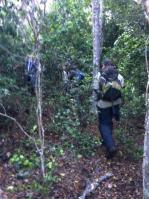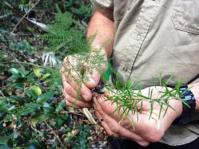In 1982, in recognition of the global significance of the island’s beauty and biodiversity, Lord Howe Island was named a UNESCO World Heritage Site . Just prior to that, The Lord Howe Island Act of 1981 was established which created a Permanent Park Preserve over approximately 70% of the island. Lord Howe Islanders are proud of the World Heritage designation and would do almost anything to preserve it.
Many programs and strategies have been introduced to protect the bio-diversity of this unique island including the 2004 establishment of The Lord Howe Island (LHI) Weed Eradication Program. This is a thirty-year plan to eliminate all non-endemic weeds from this island of fourteen-and-a-half-kilometers. A big part of this plan includes The Weed Team.
The Weed Team is a group of approximately ten-paid employees plus a variety of volunteers who are committed to removing non-endemic weeds which, if left to their own devices, will kill the rare plants which cover the hills of Lord Howe and take over the beautiful landscape. The Weed Team spends eight-hours per day, four-days per week, climbing into the hills on a search-and-destroy mission to eradicate very specific invasive weeds.
I had the opportunity to spend a day foraging through the jungle with the Weed Team and, let me tell you, these folks work hard; so hard that one can tell, they don’t simply do it for the money. These men and women are passionate about what they do.
We met in town at their garage behind the island’s board offices. I was provided with a backpack (though you should bring your own), some gloves, a tool-belt with clippers and a knife, and an empty weed-bag to fill.
We climb into their pick-up truck and head out to today’s grid. The island has been divided into hundreds of grids, which are marked by blue tape placed on trees, and a different grid is targeted each day. The Weed Team completes the full circuit every two-years. There are 670-non-native plants and, of those, 271 are considered invasive. The Weed Team eradication program targets the worst thirty-five.
 Today’s grid is a fairly easily accessible one (I think they’ve chosen it as they knew I’d be joining them) and, after leaving the truck on a muddy hill (the truck begins sliding
Today’s grid is a fairly easily accessible one (I think they’ve chosen it as they knew I’d be joining them) and, after leaving the truck on a muddy hill (the truck begins sliding  sideways so we bale-out), we begin a ten-minute walk into the jungle-covered hills. Upon our arrival at today’s grid, I’m shown the two species of weeds which we’ll be pulling, and instructed on the proper way to dig them up and cut the roots off. There’s no need to bring the entire weed out of the jungle because, if we find a lot of them, our weed bags will become quite heavy. Simply carrying the root out of the jungle will prevent further spread.
sideways so we bale-out), we begin a ten-minute walk into the jungle-covered hills. Upon our arrival at today’s grid, I’m shown the two species of weeds which we’ll be pulling, and instructed on the proper way to dig them up and cut the roots off. There’s no need to bring the entire weed out of the jungle because, if we find a lot of them, our weed bags will become quite heavy. Simply carrying the root out of the jungle will prevent further spread.
While this is a planned thirty-year program, in the ten-years it’s been in existence, they’ve reduced these invasive weeds by eighty-percent. While many on the Weed Team are rock-climbers, not all areas of Lord Howe are accessible, even to them. In these cases, a helicopter is brought in for very targeted spraying of the weeds which has a minimal impact on other plant life.
We’re spread out on a search-line, much like ones formed by police when searching for missing people. Sometimes we walk, other times we crawl in order to make a thorough search of the jungle for the, sometimes, tiny weeds hiding under dead palm leaves. The original weeds were mostly brought by visiting ships and from people’s gardens. They don’t belong here and, as they compete with other vegetation for sunlight, water and nutrients from the soil, some take over the food source for endemic, flightless, Lord Howe Wood Hens.
The original weeds were mostly brought by visiting ships and from people’s gardens. They don’t belong here and, as they compete with other vegetation for sunlight, water and nutrients from the soil, some take over the food source for endemic, flightless, Lord Howe Wood Hens.
We break for tea and lunch, eating our packed snacks and sandwiches under the jungle canopy (mostly) hidden from the sudden rains. While sitting there, we report the number of each type of weed, and its stage of development to the team leader. After thirty-minutes, we’re back at it, on our hands and knees, using our knives to dig out the unwelcome weeds. Though the Weed Team is normally out there until 3:00pm, today is a short day in the jungle as they need to report to the museum for a required class. We hike out of the jungle, this time down slippery rocks, up hillsides, and through the jungle plants, which continuously tangle in our legs, before finally reaching the pick-up which has been moved to meet us.
Though the Weed Team is normally out there until 3:00pm, today is a short day in the jungle as they need to report to the museum for a required class. We hike out of the jungle, this time down slippery rocks, up hillsides, and through the jungle plants, which continuously tangle in our legs, before finally reaching the pick-up which has been moved to meet us.
Besides it’s UNESCO World Heritage designation, why is LHI so committed to this weed eradication? Well, again, there’s the protection of the Wood Hens. But there are also 238-native plants here and 113 of them exist only on Lord Howe Island. That’s pretty amazing in its own right and, considering the size of the island, well, it’s quite remarkable. The goal of the Weed Eradication Program is zero-weed density by 2034. Being an island, there is a very realistic possibility of complete eradication of non-endemic species.
You can volunteer on the LHI Weed Team, but there are things to keep in mind:
First, this is not a vacation. Sure you’ll get to enjoy the incredible scenery of this unique island, and even meet many of the 350 locals. And you’ll learn so much about the native plant and bird-life. But, make no mistake, the work is physical and you’ll work your butt off. Still, your three-week volunteer experience will include your lodging and a small food stipend. And you’re sure to be in great physical shape after this. If you’re interested in the Weed Eradication Program, or in volunteering, or in any other LHI information, please visit http://www.lhib.nsw.gov.au/ for more information.

